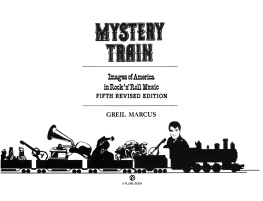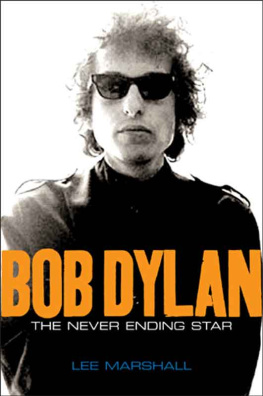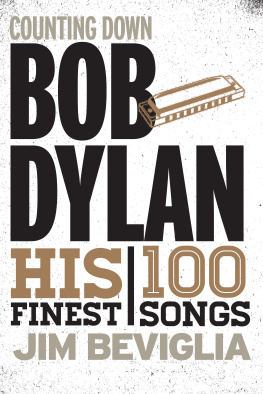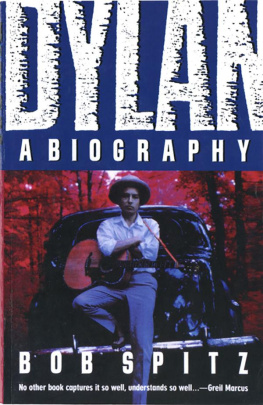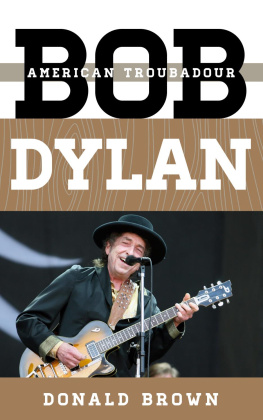FOLK MUSIC

FOLK MUSIC
A Bob Dylan Biography in Seven Songs
Greil Marcus
Illustrations by Max Clarke
Yale
UNIVERSITY PRESS
New Haven and London
Frontispiece : James Baldwin and Bob Dylan at the Emergency Civil Liberties Committee dinner on the occasion of the 172nd anniversary of the ratification of the Bill of Rights, Americana Hotel, New York, December 13, 1963 (Copyright 1963 Ted Russell).
Published with assistance from the foundation established in memory of Calvin Chapin of the Class of 1788, Yale College.
COPYRIGHT 2022 BY GREIL MARCUS .
All rights reserved.
This book may not be reproduced, in whole or in part, including illustrations, in any form (beyond that copying permitted by Sections 107 and 108 of the U.S. Copyright Law and except by reviewers for the public press), without written permission from the publishers.
Yale University Press books may be purchased in quantity for educational, business, or promotional use. For information, please e-mail (U.K. office).
Designed by Dustin Kilgore and set by Karen Stickler in Source Serif and WTR Gothic Open Shaded.
Printed in Great Britain.
Library of Congress Control Number: 2022930711
ISBN 978-0-300-25531-7 (hardcover : alk. paper)
A catalogue record for this book is available from the British Library.
This paper meets the requirements of ANSI/NISO Z39.48-1992
(Permanence of Paper).
10 9 8 7 6 5 4 3 2 1
ALSO BY GREIL MARCUS
Mystery Train: Images of America in Rock n Roll Music(1975, Folio Society edition 2020)
Lipstick Traces: A Secret History of the Twentieth Century (1989, 2009)
Dead Elvis: A Chronicle of a Cultural Obsession (1991)
Ranters & Crowd Pleasers: Punk in Pop Music, 19771992 (1993, published 1999 as In the Fascist Bathroom: Writings on Punk, 19771992)
The Dustbin of History (1995)
Invisible Republic: Bob Dylans Basement Tapes (1997, published 2000 as The Old Weird America: The World of Bob Dylans Basement Tapes)
Double Trouble: Bill Clinton and Elvis Presley in a World of No Alternatives (2000)
The Manchurian Candidate (2002, 2020)
Like a Rolling Stone: Bob Dylan at the Crossroads (2005)
The Shape of Things to Come: Prophecy and the American Voice (2006)
When That Rough God Goes Riding: Listening to Van Morrison (2010)
Bob Dylan by Greil Marcus: Writings, 19682010 (2010)
The Doors: A Lifetime of Listening to Five Mean Years (2011)
The History of Rock n Roll in Ten Songs (2014)
Three Songs, Three Singers, Three Nations (2015)
Real Life Rock: The Complete Top Ten Columns, 19862014 (2015)
Under the Red White and Blue: Patriotism, Disenchantment and the Stubborn Myth of The Great Gatsby (2020)
More Real Life Rock: The Wilderness Years, 20142021 (2022)
AS EDITOR
Stranded (1979, 2007)
Psychotic Reactions & Carburetor Dung, by Lester Bangs (1987)
The Rose & the Briar: Death, Love, and Liberty in the American Ballad (2004, with Sean Wilentz)
Best Music Writing 2009 (2009)
A New Literary History of America (2009, with Werner Sollors)
To Cecily and Steve
Let me do another song, he said to Wilson. Ill come back to this.
No, Wilson said. Finish up this one. Youll hang us up on the order, and if Im not here to edit, the other cat will get mixed up. Just do an insert of the last part.
Let him start from the beginning, man, said one of the four friends sitting behind Wilson.
Wilson turned around, looking annoyed. Why, man?
You dont start telling a story with Chapter Eight, man, the friend said.
Oh, man, said Wilson. What kind of philosophy is that? Were recording, not writing a biography.
Bob Dylan and friends in the studio with the producer Tom Wilson, recording I Shall Be Free No. 10 for Another Side of Bob Dylan
CONTENTS
FOLK MUSIC
BIOGRAPHY
Bob Dylan was born Robert Allen Zimmerman on May 24, 1941, in Duluth, Minnesota, where U.S. Highway 61 passes through on its way to its beginning at the Canadian border and its end at the Gulf of Mexico. He grew up in the mining town of Hibbing on the Iron Range, where he led high-school bands playing doo-wop and radio hits, and briefly attended the University of Minnesota in Minneapolis, where he was drawn to the Twin Cities milieu of traditional American music, and began to play coffeehouses in Dinkytown, the bohemian outpost just off campus. In late 1960, he left for New York City; by the end of 1961, as one of many voices in Greenwich Village, the center of the folk revival then making its way through the country, he was recording his first album for Columbia Records, and soon after that was taken on by the manager Albert Grossman, as powerful a man as anyone in folk music. By 1965, through visionary songs that even if they were taken from the news were somehow not time-boundsongs about injustice, war, and the meaning of freedom, at first, as with A Hard Rains A-Gonna Fall and The Lonesome Death of Hattie Carroll performed as if by a troubadour, a lone traveler with a guitar, then, with Bob Dylans 115th Dream and Like a Rolling Stone performed by a shape-shifting dandy leading a complete rock n roll bandhe was a world figure. He had taken off as a star into the firmament, the Irish folk singer Liam Clancy said to the biographer Howard Sounes of the many drug deaths and suicides among those in the folk world who were left behind. He was one of us and, suddenly, there he was. [He] was what every one of us probably hoped to be, and [we] realized now that the lightning had struck. It couldnt strike twice. The poet laureate of rock n roll! came the announcement at shows forty years later, with stage manager Al Santoss hysterical tone both quoting and parodying a 2002 piece by the Buffalo News writer Jeff Miers previewing an upcoming concert: The voice of the promise of the 60s counter-culture. The guy who forced folk into bed with rock, who donned makeup in the 70s and disappeared into a haze of substance abuse, who emerged to find Jay-sus, who was written off as a has-been by the end of the 80s, and who suddenly shifted gears and released some of the strongest music of his career beginning in the late 90s. Ladies and gentlemen, Columbia recording artist Bob Dylan! In 2010, he performed The Times They Are A-Changin at the White House (and vanished without a word, Barack Obama later wrote). In 2016 he was awarded the Nobel Prize for literature. In 2020, with the posting of his seventeen-minute Murder Most Foul on his own website, he topped the Billboard singles chart for the first time. In the fall of 2021 he announced a tour scheduled to run through 2024. Across the top of the tour poster was a banner. THINGS ARENT WHAT THEY WERE ... it read.
IN OTHER LIVES
I can see myself in others, Bob Dylan said in Rome in 2001, speaking to a crowd of journalists, and if there is a key to his work from now back to its start, that may be it. The engine of his songs is empathy: the desire and the ability to enter other lives, even to restage and re-enact the dramas others have played out, in search of different endings. That can mean slipping into a situationhistorical, as with the men behind the different voices in Who Killed Davy Moore? or invented, as with the farmer in Ballad of Hollis Brown, or inherited from other songs, especially songs without named authors or knowable provenance, as from the stage if never on record the thief in When First Unto This Country, or in Jim Jones on
Next page

